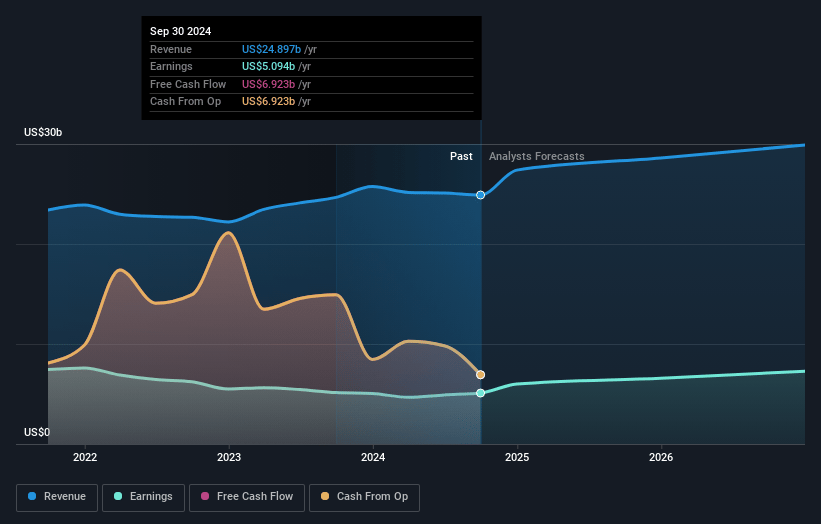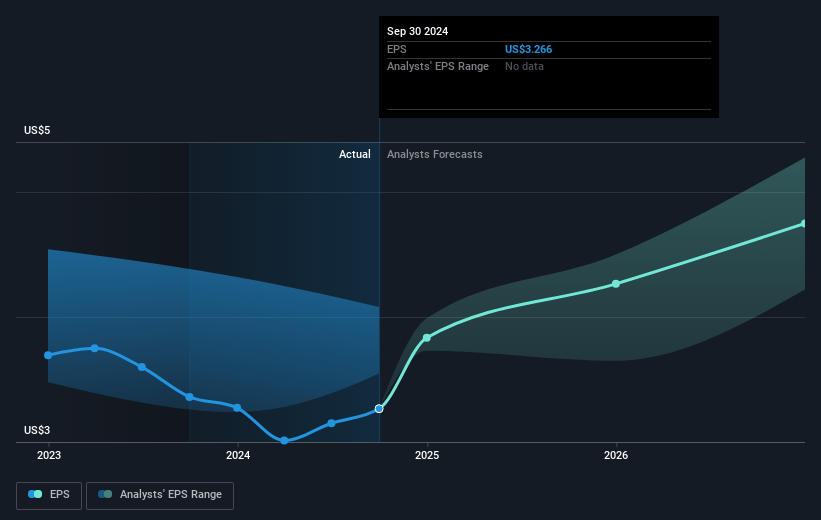Narratives are currently in beta
Key Takeaways
- U.S. Bancorp is driving revenue growth through improved interest income and expanded fee-based business channels, enhancing future earnings prospects.
- Strategic initiatives in digital capabilities and share repurchases aim to improve customer engagement and boost shareholder value.
- Challenges in deposit growth, loan stagnation, investment losses, and reliance on market conditions indicate potential volatility in U.S. Bancorp's earnings and profitability.
Catalysts
About U.S. Bancorp- A financial services holding company, provides various financial services to individuals, businesses, institutional organizations, governmental entities, and other financial institutions in the United States.
- U.S. Bancorp is focusing on driving revenue growth through improved net interest income, aided by an enhanced loan mix and strategic investment portfolio actions, which could positively impact future earnings.
- The company's commitment to expanding its distribution channels, particularly in fee-based businesses such as trust and investment management, payments, and treasury management, is expected to bolster noninterest income and drive revenue growth.
- Tight expense management and efficiency improvements are positioning the company to achieve positive operating leverage, which could lead to improved net margins over time.
- Planned strategic initiatives in digital capabilities and integrated payment solutions are anticipated to enhance customer experience and engagement, potentially leading to increased revenue and improved net interest margins.
- U.S. Bancorp's share repurchase program, supported by a strong capital ratio, could drive earnings per share growth, enhancing shareholder value and supporting stock valuation.
U.S. Bancorp Future Earnings and Revenue Growth
Assumptions
How have these above catalysts been quantified?- Analysts are assuming U.S. Bancorp's revenue will grow by 7.5% annually over the next 3 years.
- Analysts assume that profit margins will increase from 20.5% today to 23.9% in 3 years time.
- Analysts expect earnings to reach $7.4 billion (and earnings per share of $4.87) by about January 2028, up from $5.1 billion today. The analysts are largely in agreement about this estimate.
- In order for the above numbers to justify the analysts price target, the company would need to trade at a PE ratio of 14.2x on those 2028 earnings, down from 14.9x today. This future PE is greater than the current PE for the US Banks industry at 12.2x.
- Analysts expect the number of shares outstanding to decline by 0.95% per year for the next 3 years.
- To value all of this in today's terms, we will use a discount rate of 6.75%, as per the Simply Wall St company report.
U.S. Bancorp Future Earnings Per Share Growth
Risks
What could happen that would invalidate this narrative?- The decline in total average deposits by 1.0% could signify challenges in sustaining deposit growth, which may impact the bank's net interest income as it prioritizes relationship-based deposits despite maintaining pricing discipline which could constrain revenue.
- The modest decrease of 0.2% in average loans indicates muted industry loan growth and continued headwinds from capital markets-related paydowns, leading to lower revenues from interest-earning assets.
- The net securities losses of $119 million within the investment portfolio contribute to a potential volatility in earnings, especially as these losses were only partly offset by tax favorability, affecting overall profitability.
- The efficiency ratio improvement might not fully offset pressures on net interest margins, which despite expanding, rely on factors like card revolve rates and disciplined deposit pricing that could change if customer dynamics or economic conditions shift, impacting earnings.
- While there is guidance for stable net interest income, the reliance on market conditions and interest rate movements presents uncertainties that could affect earnings projections if there are rate changes that do not align with current expectations.
Valuation
How have all the factors above been brought together to estimate a fair value?- The analysts have a consensus price target of $56.97 for U.S. Bancorp based on their expectations of its future earnings growth, profit margins and other risk factors. However, there is a degree of disagreement amongst analysts, with the most bullish reporting a price target of $65.0, and the most bearish reporting a price target of just $49.0.
- In order for you to agree with the analyst's consensus, you'd need to believe that by 2028, revenues will be $30.9 billion, earnings will come to $7.4 billion, and it would be trading on a PE ratio of 14.2x, assuming you use a discount rate of 6.8%.
- Given the current share price of $48.7, the analyst's price target of $56.97 is 14.5% higher.
- We always encourage you to reach your own conclusions though. So sense check these analyst numbers against your own assumptions and expectations based on your understanding of the business and what you believe is probable.
How well do narratives help inform your perspective?
Disclaimer
Warren A.I. is a tool utilizing a Large Language Model (LLM) that ingests data on consensus price targets, forecasted revenue and earnings figures, as well as the transcripts of earnings calls to produce qualitative analysis. The narratives produced by Warren A.I. are general in nature and are based solely on analyst data and publicly-available material published by the respective companies. These scenarios are not indicative of the company's future performance and are exploratory in nature. Simply Wall St has no position in the company(s) mentioned. The price targets and estimates used are consensus data, and do not constitute a recommendation to buy or sell any stock, and they do not take account of your objectives, or your financial situation. Note that Warren A.I.'s analysis may not factor in the latest price-sensitive company announcements or qualitative material.
Read more narratives
There are no other narratives for this company.
View all narratives



